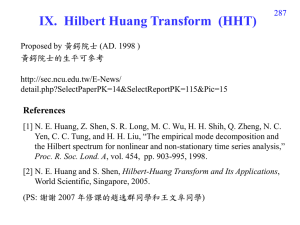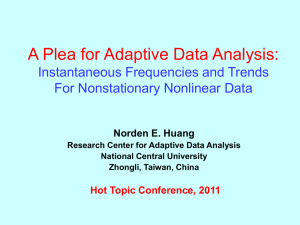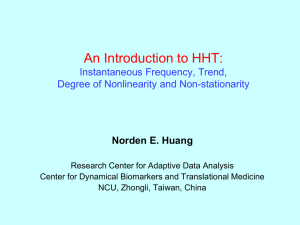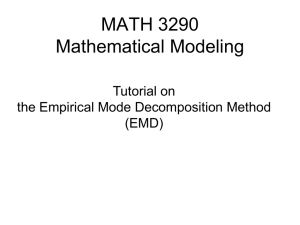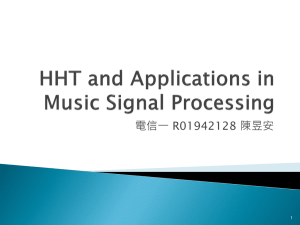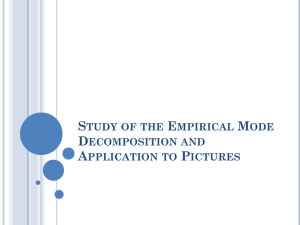Frequency
advertisement
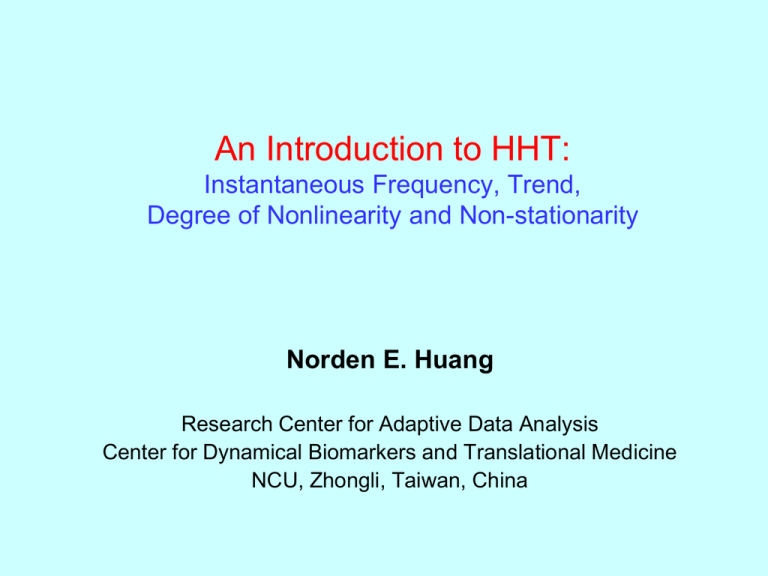
An Introduction to HHT: Instantaneous Frequency, Trend, Degree of Nonlinearity and Non-stationarity Norden E. Huang Research Center for Adaptive Data Analysis Center for Dynamical Biomarkers and Translational Medicine NCU, Zhongli, Taiwan, China Outline Rather than the implementation details, I will talk about the physics of the method. • What is frequency? • How to quantify the degree of nonlinearity? • How to define and determine trend? What is frequency? It seems to be trivial. But frequency is an important parameter for us to understand many physical phenomena. Definition of Frequency Given the period of a wave as T ; the frequency is defined as 1 T . Instantaneous Frequency Velocity distance ; mean velocity time Newton v Frequency dx dt 1 ; mean frequency period HHT defines the phase function d dt So that both v and can appear in differential equations. Other Definitions of Frequency : For any data from linear Processes 1. Fourier Analysis : T F ( ) x( t ) e j i jt dt . 0 2. Wavelet Analysis 3. Wigner Ville Analysis Definition of Power Spectral Density Since a signal with nonzero average power is not square integrable, the Fourier transforms do not exist in this case. Fortunately, the Wiener-Khinchin Theroem provides a simple alternative. The PSD is the Fourier transform of the auto-correlation function, R(τ), of the signal if the signal is treated as a widesense stationary random process: S( ) R( )e 2i d S( )d 2 ( t ) Fourier Spectrum Problem with Fourier Frequency • Limited to linear stationary cases: same spectrum for white noise and delta function. • Fourier is essentially a mean over the whole domain; therefore, information on temporal (or spatial) variations is all lost. • Phase information lost in Fourier Power spectrum: many surrogate signals having the same spectrum. Surrogate Signal: Non-uniqueness signal vs. Power Spectrum I. Hello The original data : Hello The surrogate data : Hello The Fourier Spectra : Hello The Importance of Phase To utilize the phase to define Instantaneous Frequency Prevailing Views on Instantaneous Frequency The term, Instantaneous Frequency, should be banished forever from the dictionary of the communication engineer. J. Shekel, 1953 The uncertainty principle makes the concept of an Instantaneous Frequency impossible. K. Gröchennig, 2001 The Idea and the need of Instantaneous Frequency According to the classic wave theory, the wave conservation law is based on a gradually changing φ(x,t) such that k , ; t k 0 . t Therefore, both wave number and frequency must have instantaneous values and differentiable. Hilbert Transform : Definition For any x( t ) Lp , y( t ) 1 x( ) d , t then, x( t )and y( t ) form the analytic pairs: z( t ) x( t ) i y( t ) a( t ) e i ( t ) , where a( t ) x 2 y 2 1 / 2 and ( t ) tan 1 y( t ) . x( t ) The Traditional View of the Hilbert Transform for Data Analysis Traditional View a la Hahn (1995) : Data LOD Traditional View a la Hahn (1995) : Hilbert Traditional Approach a la Hahn (1995) : Phase Angle Traditional Approach a la Hahn (1995) : Phase Angle Details Traditional Approach a la Hahn (1995) : Frequency The Real World Mathematics are well and good but nature keeps dragging us around by the nose. Albert Einstein Why the traditional approach does not work? Hilbert Transform a cos + b : Data Hilbert Transform a cos + b : Phase Diagram Hilbert Transform a cos + b : Phase Angle Details Hilbert Transform a cos + b : Frequency The Empirical Mode Decomposition Method and Hilbert Spectral Analysis Sifting (Other alternatives, e.g., Nonlinear Matching Pursuit) Empirical Mode Decomposition: Methodology : Test Data Empirical Mode Decomposition: Methodology : data and m1 Empirical Mode Decomposition: Methodology : data & h1 Empirical Mode Decomposition: Methodology : h1 & m2 Empirical Mode Decomposition: Methodology : h3 & m4 Empirical Mode Decomposition: Methodology : h4 & m5 Empirical Mode Decomposition Sifting : to get one IMF component x( t ) m 1 h1 , h1 m 2 h2 , ..... ..... hk 1 m k hk . hk c1 . The Stoppage Criteria The Cauchy type criterion: when SD is small than a preset value, where T SD h t 0 k 1 ( t ) hk ( t ) 2 T 2 h k 1 ( t ) t 0 Or, simply pre-determine the number of iterations. Empirical Mode Decomposition: Methodology : IMF c1 Definition of the Intrinsic Mode Function (IMF): a necessary condition only! Any function having the same numbers of zero cros sin gs and extrema ,and also having symmetric envelopes defined by local max ima and min ima respectively is defined as an Intrinsic Mode Function ( IMF ). All IMF enjoys good Hilbert Transform : c( t ) a( t )e i ( t ) Empirical Mode Decomposition: Methodology : data, r1 and m1 Empirical Mode Decomposition Sifting : to get all the IMF components x( t ) c1 r1 , r1 c2 r2 , . . . rn 1 cn rn . x( t ) n c j1 j rn . Definition of Instantaneous Frequency The Fourier Transform of the Instrinsic Mode Funnction, c( t ), gives W ( ) i ( t ) a( t ) e dt t By Stationary phase approximation we have d ( t ) , dt This is defined as the Ins tan tan eous Frequency . An Example of Sifting & Time-Frequency Analysis Length Of Day Data LOD : IMF Orthogonality Check • Pair-wise % • Overall % • • • • • • • • • • • 0.0003 0.0001 0.0215 0.0117 0.0022 0.0031 0.0026 0.0083 0.0042 0.0369 0.0400 • 0.0452 LOD : Data & c12 LOD : Data & Sum c11-12 LOD : Data & sum c10-12 LOD : Data & c9 - 12 LOD : Data & c8 - 12 LOD : Detailed Data and Sum c8-c12 LOD : Data & c7 - 12 LOD : Detail Data and Sum IMF c7-c12 LOD : Difference Data – sum all IMFs Traditional View a la Hahn (1995) : Hilbert Mean Annual Cycle & Envelope: 9 CEI Cases Mean Hilbert Spectrum : All CEs
